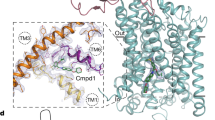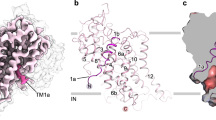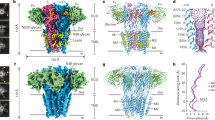Abstract
Functional glycine receptors (GlyRs) are enriched in the hippocampus, but their role in hippocampal function remains unclear. Since the concentration of ambient glycine is determined by the presence of powerful glycine transporter (GlyT), we blocked the reuptake of glycine in hippocampal slices to examine the role of GlyRs. Antagonists of GlyT type 1 (GlyT1) but not that of GlyT type 2 (GlyT2) induced excitatory postsynaptic potential (EPSP)-spike depression, which was reversed by the specific GlyR antagonist strychnine. Moreover, endogenously elevating the glycine concentration with the GlyT1 antagonists facilitated NMDA receptor-dependent long-term potentiation induction, and elicited a strychnine-sensitive chloride current. In addition, impairment of glial function with fluoroacetate blocked the effect of GlyT1 antagonists on the EPSP-spike curve. Furthermore, pretreatment with sarcosine was effective in controlling pentylenetetrazol-induced seizures. These results indicate an essential role of GlyTs in fine-tuning tonic activation of GlyRs and suggest a potential role of GlyR-dependent EPSP-spike depression in hippocampal network stability.
Similar content being viewed by others
Log in or create a free account to read this content
Gain free access to this article, as well as selected content from this journal and more on nature.com
or
References
Aubrey KR, Mitrovic AD, Vandenberg RJ (2000). Molecular basis for proton regulation of glycine transport by glycine transporter subtype 1b. Mol Pharmacol 58: 129–135.
Baker AJ, Zornow MH, Scheller MS, Yaksh TL, Skilling SR, Smullin DH et al (1991). Changes in extracellular concentrations of glutamate, aspartate, glycine, dopamine, serotonin, and dopamine metabolites after transient global ischemia in the rabbit brain. J Neurochem 57: 1370–1379.
Becker CM, Betz H, Schroder H (1993). Expression of inhibitory glycine receptors in postnatal rat cerebral-cortex. Brain Res 606: 220–226.
Berger SJ, Carter JC, Lowry OH (1977). The distribution of glycine, GABA, glutamate and aspartate in rabbit spinal cord, cerebellum and hippocampus. J Neurochem 28: 149–158.
Bezzi P, Volterra A (2001). A neuron-glia signalling network in the active brain. Curr Opin Neurobiol 11: 387–394.
Bliss TV, Lomo T (1973). Long-lasting potentiation of synaptic transmission in the dentate area of the anaesthetized rabbit following stimulation of the perforant path. J Physiol 232: 331–356.
Bradaia A, Schlichter R, Trouslard J (2004). Role of glial and neuronal glycine transporters in the control of glycinergic and glutamatergic synaptic transmission in lamina X of the rat spinal cord. J Physiol 559: 169–186.
Chattipakorn SC, McMahon LL (2002). Pharmacological characterization of glycine-gated chloride currents recorded in rat hippocampal slices. J Neurophysiol 87: 1515–1525.
Chattipakorn SC, McMahon LL (2003). Strychnine-sensitive glycine receptors depress hyperexcitability in rat dentate gyrus. J Neurophysiol 89: 1339–1342.
Chavez-Noriega LE, Bliss TV, Halliwell JV (1989). The EPSP-spike (E-S) component of long-term potentiation in the rat hippocampal slice is modulated by GABAergic but not cholinergic mechanisms. Neurosci Lett 104: 58–64.
Chen L, Muhlhauser M, Yang CR (2003). Glycine tranporter-1 blockade potentiates NMDA-mediated responses in rat prefrontal cortical neurons in vitro and in vivo. J Neurophysiol 89: 691–703.
Fonnum F, Johnsen A, Hassel B (1997). Use of fluorocitrate and fluoroacetate in the study of brain metabolism. Glia 21: 106–113.
Geerlings A, Lopez-Corcuera B, Aragon C (2000). Characterization of the interactions between the glycine transporters GLYT1 and GLYT2 and the SNARE protein syntaxin 1A. FEBS Lett 470: 51–54.
Gomeza J, Ohno K, Betz H (2003). Glycine transporter isoforms in the mammalian central nervous system: structures, functions and therapeutic promises. Curr Opin Drug Discov Devel 6: 675–682.
Holopainen I, Kontro P (1989). Uptake and release of glycine in cerebellar granule cells and astrocytes in primary culture: potassium-stimulated release from granule cells is calcium-dependent. J Neurosci Res 24: 374–383.
Huang H, Barakat L, Wang D, Bordey A (2004). Bergmann glial GlyT1 mediates glycine uptake and release in mouse cerebellar slices. J Physiol 560: 721–736.
Ju P, Aubrey KR, Vandenberg RJ (2004). Zn2+ inhibits glycine transport by glycine transporter subtype 1b. J Biol Chem 279: 22983–22991.
Jursky F, Nelson N (1995). Localization of glycine neurotransmitter transporter (GLYT2) reveals correlation with the distribution of glycine receptor. J Neurochem 64: 1026–1033.
Kinney GG, Sur C, Burno M, Mallorga PJ, Williams JB, Figueroa DJ et al (2003). The glycine transporter type 1 inhibitor N-[3-(4′-fluorophenyl)-3-(4′-phenylphenoxy)propyl]sarcosine potentiates NMDA receptor-mediated responses in vivo and produces an antipsychotic profile in rodent behavior. J Neurosci 23: 7586–7591.
Kirchner A, Breustedt J, Rosche B, Heinemann UF, Schmieden V (2003). Effects of taurine and glycine on epileptiform activity induced by removal of Mg2+ in combined rat entorhinal cortex–hippocampal slices. Epilepsia 44: 1145–1152.
Krishtal OA, Osipchuk YV, Shelest TN, Smirnoff SV (1987). Rapid extracellular pH transients related to synaptic transmission in rat hippocampal slices. Brain Res 436: 352–356.
Legendre P (2001). The glycinergic inhibitory synapse. Cell Mol Life Sci 58: 760–793.
Li Y, Wu LJ, Legendre P, Xu TL (2003). Asymmetric cross-inhibition between GABAA and glycine receptors in rat spinal dorsal horn neurons. J Biol Chem 278: 38637–38645.
Li Y, Xu TL (2002). State-dependent cross-inhibition between anionic GABA(A) and glycine ionotropic receptors in rat hippocampal CA1 neurons. Neuroreport 13: 223–226.
Lim R, Hoang PD, Berger AJ (2004). Blockade of glycine transporter-1 (GLYT-1) potentiates NMDA-receptor mediated synaptic transmission in hypoglossal motorneurons. J Neurophysiol 92: 2530–2537.
Lopez-Colome AM, Gadea A (1999). Regulation of glycine transport in cultured Muller cells by Ca2+/calmodulin-dependent enzymes. Ann NY Acad Sci 868: 685–688.
Lu YM, Mansuy IM, Kandel ER, Roder J (2000). Calcineurin-mediated LTD of GABAergic inhibition underlies the increased excitability of CA1 neurons associated with LTP. Neuron 26: 197–205.
Malosio ML, Marqueze-Pouey B, Kuhse J, Betz H (1991). Widespread expression of glycine receptor subunit mRNAs in the adult and developing rat brain. EMBO J 10: 2401–2409.
Martina M, Gorfinkel Y, Halman S, Lowe JA, Periyalwar P, Schmidt CJ et al (2004). Glycine transporter type 1 blockade changes NMDA receptor-mediated responses and LTP in hippocampal CA1 pyramidal cells by altering extracellular glycine levels. J Physiol 557: 489–500.
Meier JC, Henneberger C, Melnick I, Racca C, Harvey RJ, Heinemann U et al (2005). RNA editing produces glycine receptor alpha3(P185L), resulting in high agonist potency. Nat Neurosci 8: 736–744.
Miller PS, Harvey RJ, Smart TG (2004). Differential agonist sensitivity of glycine receptor alpha2 subunit splice variants. Br J Pharmacol 143: 19–26.
Mody I, De Koninck Y, Otis TS, Soltesz I (1994). Bridging the cleft at GABA synapses in the brain. Trends Neurosci 17: 517–525.
Mori M, Gahwiler BH, Gerber U (2002). Beta-alanine and taurine as endogenous agonists at glycine receptors in rat hippocampus in vitro. J Physiol 539: 191–200.
Mothet JP, Pollegioni L, Ouanounou G, Martineau M, Fossier P, Baux G (2005). Glutamate receptor activation triggers a calcium-dependent and SNARE protein-dependent release of the gliotransmitter D-serine. Proc Natl Acad Sci USA 102: 5606–5611.
Nong Y, Huang YQ, Ju W, Kalia LV, Ahmadian G, Wang YT et al (2003). Glycine binding primes NMDA receptor internalization. Nature 422: 302–307.
Pearlman RJ, Aubrey KR, Vandenberg RJ (2003). Arachidonic acid and anandamide have opposite modulatory actions at the glycine transporter, GLYT1a. J Neurochem 84: 592–601.
Psarropoulou C, Matsokis N, Angelatou F, Kostopoulos G (1994). Pentylenetetrazol-induced seizures decrease gamma-aminobutyric acid-mediated recurrent inhibition and enhance adenosine-mediated depression. Epilepsia 35: 12–19.
Qian J, Noebels JL (2005). Visualization of transmitter release with zinc fluorescence detection at the mouse hippocampal mossy fibre synapse. J Physiol 566: 747–758.
Rivera C, Voipio J, Payne JA, Ruusuvuori E, Lahtinen H, Lamsa K et al (1999). The K+/Cl− co-transporter KCC2 renders GABA hyperpolarizing during neuronal maturation. Nature 397: 251–255.
Sato K, Adams R, Betz H, Schloss P (1995). Modulation of a recombinant glycine transporter (GLYT1b) by activation of protein kinase C. J Neurochem 65: 1967–1973.
Seiler N, Sarhan S (1984). Synergistic anticonvulsant effects of GABA-T inhibitors and glycine. Naunyn Schmiedebergs Arch Pharmacol 326: 49–57.
Shleper M, Kartvelishvily E, Wolosker H (2005). D-serine is the dominant endogenous coagonist for NMDA receptor neurotoxicity in organotypic hippocampal slices. J Neurosci 25: 9413–9417.
Smith KE, Borden LA, Hartig PR, Branchek T, Weinshank RL (1992). Cloning and expression of a glycine transporter reveal colocalization with NMDA receptors. Neuron 8: 927–935.
Staff NP, Spruston N (2003). Intracellular correlate of EPSP-spike potentiation in CA1 pyramidal neurons is controlled by GABAergic modulation. Hippocampus 13: 801–805.
Swanson RA, Graham SH (1994). Fluorocitrate and fluoroacetate effects on astrocyte metabolism in vitro. Brain Res 664: 94–100.
Thio LL, Shanmugam A, Isenberg K, Yamada K (2003). Benzodiazepines block alpha2-containing inhibitory glycine receptors in embryonic mouse hippocampal neurons. J Neurophysiol 90: 89–99.
Thomson AM, Walker VE, Flynn DM (1989). Glycine enhances NMDA-receptor mediated synaptic potentials in neocortical slices. Nature 338: 422–424.
Turrigiano GG, Nelson SB (2004). Homeostatic plasticity in the developing nervous system. Nat Rev Neurosci 5: 97–107.
Ventura R, Harris KM (1999). Three-dimensional relationships between hippocampal synapses and astrocytes. J Neurosci 19: 6897–6906.
Wu ZY, Xu TL (2003). Taurine-evoked chloride current and its potentiation by intracellular Ca2+ in immature rat hippocampal CA1 neurons. Amino Acids 24: 155–161.
Yoon KW, Wotring VE, Fuse T (1998). Multiple picrotoxinin effect on glycine channels in rat hippocampal neurons. Neuroscience 87: 807–815.
Zafra F, Alcantara R, Gomeza J, Aragon C, Gimenez C (1990). Arachidonic acid inhibits glycine transport in cultured glial cells. Biochem J 271: 237–242.
Zafra F, Aragon C, Olivares L, Danbolt NC, Gimenez C, Storm-Mathisen J (1995). Glycine transporters are differentially expressed among CNS cells. J Neurosci 15: 3952–3969.
Acknowledgements
This study was supported by the National Natural Science Foundation of China (No. 30621062), the National Basic Research Program of China (No. 2006CB500803) and the Knowledge Innovation Project from the Chinese Academy of Sciences (KSCX2-YW-R-35). We thank Dr Iain Bruce (Hong Kong University, Hong Kong) for proofreading the manuscript.
Author information
Authors and Affiliations
Corresponding author
Additional information
Competing interest statement
The authors declare that they have no competing financial interests.
Rights and permissions
About this article
Cite this article
Zhang, LH., Gong, N., Fei, D. et al. Glycine Uptake Regulates Hippocampal Network Activity via Glycine Receptor-Mediated Tonic Inhibition. Neuropsychopharmacol 33, 701–711 (2008). https://doi.org/10.1038/sj.npp.1301449
Received:
Revised:
Accepted:
Published:
Issue date:
DOI: https://doi.org/10.1038/sj.npp.1301449
Keywords
This article is cited by
-
Hetero-pentamerization determines mobility and conductance of Glycine receptor α3 splice variants
Cellular and Molecular Life Sciences (2022)
-
Neuronal Nsun2 deficiency produces tRNA epitranscriptomic alterations and proteomic shifts impacting synaptic signaling and behavior
Nature Communications (2021)
-
Non-selective COX inhibitors impair memory formation and short-term but not long-term synaptic plasticity
Naunyn-Schmiedeberg's Archives of Pharmacology (2021)
-
Monitoring hippocampal glycine with the computationally designed optical sensor GlyFS
Nature Chemical Biology (2018)
-
Metabolic modulation of neuronal gamma-band oscillations
Pflügers Archiv - European Journal of Physiology (2018)



